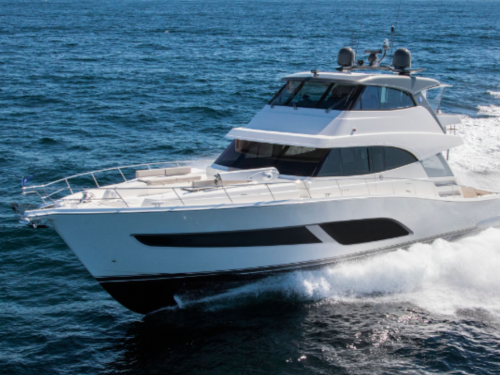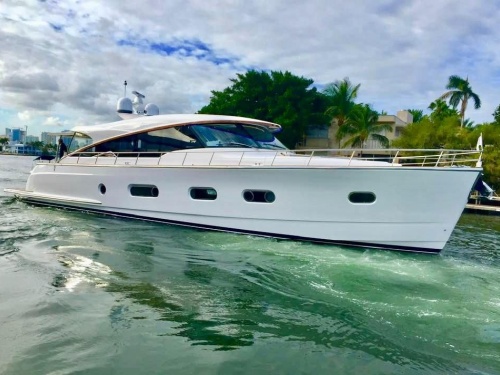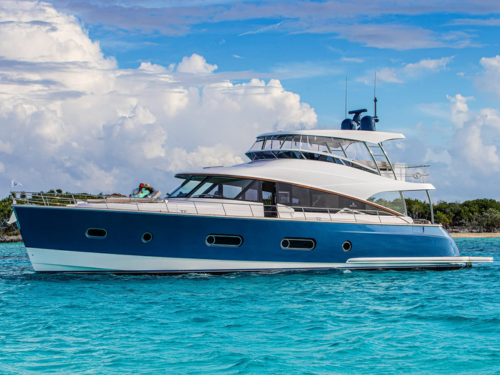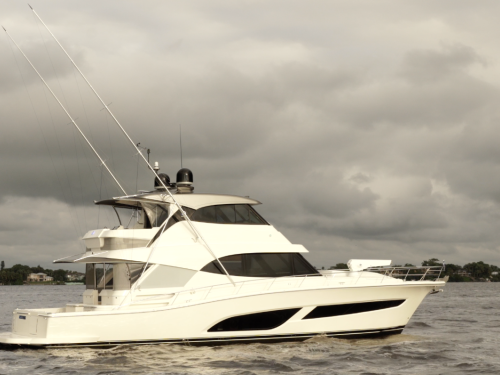Access More Boat Tests
Already have an account? Login
Riviera 72 Sports Motor Yacht (2019-)
2 x 1,900-hp MAN V12
Price
See the price by becoming
a BoatTEST member.
Members Must Log In
Brief Summary
The Riviera 72 Sports Motor Yacht is designed for long-distance cruising, world-class sportfishing and entertaining close to home during the day and at night.
Her construction, fit-and-finish, standard equipment and amenities leave very little to be desired for most missions. She comes in three or four-stateroom versions and is designed to be an owner/operator vessel.
Key Features
- Enclosed flying bridge
- Three or four staterooms
- V-Drive
- 175-sq.-ft. (16.32 m) cockpit
- Aft galley
Test Results
| RPM | MPH | Knots | GPH | MPG | NMPG | STAT. MILE | NM | dBa |
|---|---|---|---|---|---|---|---|---|
| 700 | 9.8 | 8.5 | 6.4 | 1.5 | 1.3 | 3833 | 3333.4 | 60 |
| 1000 | 12.8 | 11.1 | 19.6 | 0.7 | 0.6 | 1635 | 1421.4 | 63 |
| 1250 | 14.9 | 12.9 | 40.3 | 0.4 | 0.3 | 920 | 800 | 67 |
| 1500 | 19.5 | 17 | 66.3 | 0.3 | 0.3 | 735 | 639 | 67 |
| 1750 | 25.5 | 22.1 | 95.6 | 0.3 | 0.2 | 665 | 577.9 | 68 |
| 2000 | 30.9 | 26.9 | 131 | 0.2 | 0.2 | 589 | 512.1 | 72 |
| 2250 | 36.3 | 31.6 | 170.5 | 0.2 | 0.2 | 532 | 462.2 | 76 |
| 2370 | 38.8 | 33.7 | 182 | 0.2 | 0.2 | 532 | 462.2 | 76 |
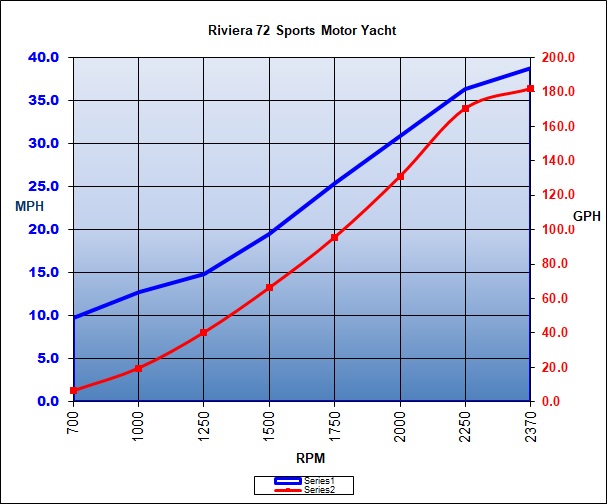
Specifications
| Length Overall |
78' 3" 23.68 m |
|---|---|
| Beam |
19' 8" 6 m |
| Dry Weight |
120,361 lbs. 54,595 kg |
| Tested Weight |
143,723 lbs. 65,192 kg |
| Draft |
6' 5" 1.96 m |
| Max Headroom |
6' 6.5" 1.99 m |
| Bridge Clearance |
24' 1'' 7.35 m |
| Fuel Capacity |
2,774 gal. 10,501 L |
| Water Capacity |
225 gal. 852 L |
| Total Weight |
143,723 lbs. 65,192 kg |
Acceleration Times & Conditions
| 0 to 30 | 21.4 sec. |
|---|---|
| Load | 6 persons, 2/3 load, 1/2 water, 5,000 lbs. of gear |
| Climate | 70 deg., 60 humid.; wind: 5-10 mph; seas: lt. chop |
Engine Options
| Tested Engine |
2 x 1,900-hp MAN V12 |
|---|---|
| Std. Power |
2 x 1,800-hp MAN V12 |
| Opt. Power |
2 x 1,900-hp MAN V12 |
Contents of Report
Mission
The mission of the Riviera 72 Sports Motor Yacht is to be a no-compromise vessel for four major missions: Sportfishing, casual coastal cruising, and watersports, such as scuba diving, world cruising, and entertaining day-boat style. As its name implies: She is a motoryacht designed for serious watersports, including big-game fishing.
Sportfishing. With her prodigious fuel capacity, at displacement speeds, she can easily range the Pacific in search of IGFA records in comfort that Zane Gray would envy, or travel from Miami, through the Caribbean to places such as Cabo Blanco, Peru for the big ones. She has a large cockpit that can be rigged for big game.
Motoryacht. All of this can be done in the comfort that rivals most conventional motoryachts because of her lower CG, reduced windage, and her optional Seakeeper gyro. Three or four staterooms allow owners to match the accommodations to the specific mission. She has six entertaining venues, more than most flushdeck motoryachts.
World Cruising. Because of her generous standard fuel tankage, 2,378 gallons (9,002 L), with 396 gallons (1,499 L) extra available as an option, the total of 2,774 gallons (10,501 L) gives her over 3,000 nm range at displacement speeds with a 10% reserve. Because of her robust build, she can also be a world cruiser that is every bit a match for specialty designs that are intended for just that specific purpose.
Entertainment Platform/Day Boat. She has as many, if not more, entertaining venues than a typical motoryacht: the cockpit, mezzanine/aft deck, bow lounge, salon, flying bridge salon, and flybridge outdoor settee.
Owner/Operator. While she has a small optional crew cabin aft, she is really intended for an owner/operator. To that end, virtually everything aboard has been designed to make her easy for a couple to cruise alone or with family and friends.
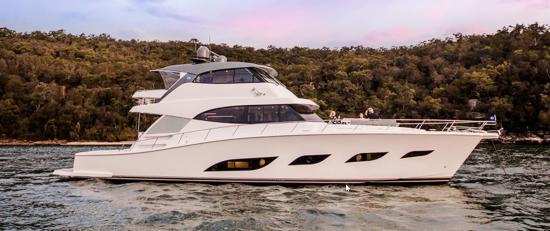
Distinguishing Features
- 2 transom doors
- Cockpit designed for big game fishing and entertaining
- Mezzanine/aft deck seats 10
- Aft galley
- Large bow entertaining venue
- Sky lounge with aft deck
- Rear helm on flying bridge as standard
- Standard bow thruster
- Frank Mulder hull design
- Resin infusion hull
- Three or four stateroom arrangements available
- Customization available
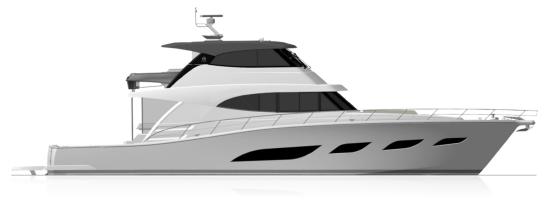
Comparison
There are not many boats like the Riviera 72 Sports Motor Yacht on the market. And, while there are 72’ (22 m) convertibles and sportsfishermen, and 72’ motoryachts, none really combine all of the major design elements of the Riviera 72. She can be a no-compromise sportfisherman, but she can also be a dive boat, a world cruiser, or a luxurious entertainment platform. She is not a gin palace, because the Australians play too hard to get trapped into a limited-use vessel of this size and expense.
Riviera 72 vs. Riviera 68
The 72 Sports Motor Yacht is nearly identical with the 68 Sports Motor Yacht except for 4’ (1.22 m) that has been added to the stern. The cockpit has been lengthened and the entertainment/bait prep console has been enlarged. As a result, the lazarette is larger making it ideal for a Seakeeper gyro, or for dive tanks with a compressor.
She has more waterline for slightly higher, easily-driven displacement speeds, and increased buoyance permits a greater fuel load while letting the boat still float on her lines. By lengthening the boat this way, owners get a larger boat, more utility, without a commensurate increase in cost because the extra length was added in an area of relative simplicity.
Change is Constant Now. Given the evolutionary nature of sportfishing, to say nothing of the changing demographics and psychographics of the public, we think having a multi-function yacht makes good sense when it comes to boats in this price range.
Customization
Riviera has an “after production” customization department. It is here that installations are made that are not on the standard or optional list, and virtually anything can be done at this point. It is not at all unusual for owners who are spending several million dollars for a yacht to want something, or several things, changed to make the boat better for their specific application. Some owners want a level of personalization that is not in the sample books, or may be too disruptive to implement during the primary construction and fit-out stages.
Prospective owners need to keep this in mind as they read this report. Virtually anything can be changed.
This department also doubles as an aftermarket repair and refurbishment facility and is handy to the local river and travelift dock. At least one owner of a used boat decided that he wanted a completely new interior, so it was here that the old one was torn out and a completely new one was built inside.
All it takes is money. And it is best to have that kind of work done here, because the people working Riviera’s plant know where every nut and bolt on the boat can be found.
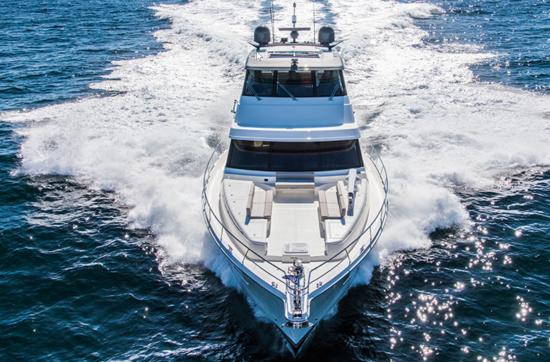
Performance
Our test vessel had a dry weight of 120,361 lbs. (54,595 kg) and with five people aboard, 67% fuel and 50% water, plus quite a bit of optional equipment, we estimate her tested weight was about 143,723 lbs. (65,192 kg). She was powered by twin MAN 12V 1900-hp diesel engines driving through Twin Disc V-Drive marine gears. On test day, the temperature was 65-degrees F with a slight breeze and light chop.
Tankage. The standard Riviera 72 Sports Motor Yacht has a fuel capacity of 2,378 gallons (9,002 L) in three tanks. An optional fourth tank is available ($24,975) which holds an additional 396 gallons (1,499 L). Out test boat was equipped with the optional tank. Altogether, our test boat had a fuel capacity of 2,774 gallons (10,501 L), which weighs over 19,000 lbs. (8,618 kgs.), making her a serious motoryacht or long-distance cruiser in anyone’s book.
WOT speed recorded was 33.7 knots (38.7 mph). At that speed from the enclosed flying bridge, there was, in fact, no sensation of going fast. The bridge was quiet. We could hardly hear the engines and virtually no crashing bow waves. At WOT speed we recorded 76 dBa at the helm in the enclosed flying bridge.
At 17 knots the sound was just 67 dbA – about that of a quiet conversation. From that high perch, the water just seemed to silently scroll under the boat, with the 120,000 lbs. (54,431 kg) of displacement mashing through normal sea chop without a murmur.
There was no best cruise, per se, as her miles per gallon is somewhat linear. Typically, owners will drive the boat at 17 to 18 knots, where the boat is on plane. At 1500 rpm she was going 17 knots and burning 66.3 gph (250.8 lph) for a range of 639 nautical miles.
Other owners might wish to go faster or slower. At 1750 rpm, we recorded 22.1 knots, burning 95.6 gph for a range of 577 nautical miles. That is more than the distance from St. Pete, Florida to Isla Mujeres, Mexico – or from Sydney, Australia to Brisbane. And, it takes less than a day to make either destination at that speed.
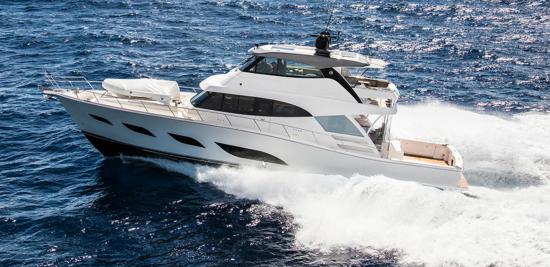
Displacement Speeds. For those who like to cruise at displacement speeds, at 1000 rpm, she travels at 11.1 knots and has a range of 1,421 nmiles, and 127 hours of endurance. This is a comfortable speed and is a good compromise between economy and speed for many owners.
At trawler speeds – 8.5 knots at 700 rpm (idle) – she has a range as good as most trawlers and long-range cruisers – 3,333 nautical miles. We happen to think that the Riviera 72 Sports Motor Yacht would make an excellent LRC in which to explore the Pacific islands. She has the tankage and the range of most displacement LRCs, plus many more amenities – and more possibilities.
For oceanic missions, of course, she would not need the 1900-hp MAN diesel and would perform admirably with less muscle. And, don’t buy into the myth that a single low-horsepower diesel would be more fuel-efficient. At idle, the Riviera 72 Sports Motor Yacht got 1.3 nmpg from her twin V-12 MANs, virtually the same as a well-known world ranger gets with a single 250-hp in-line 6 diesel, and that boat weighed less than half as much.
Acceleration tests clocked her at 20 mph in 13.8 seconds and hitting 30 mph in 21.4 seconds. These are noteworthy times for a vessel of this displacement. The MAN 1900s put out prodigious torque and the massive Twin Disc marine V-drive gears can handle it. There are times when this kind of acceleration could be important, and it’s good to know what the vessel is capable of.
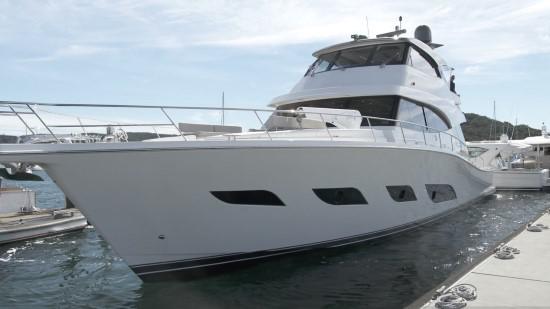
Handling
Offshore, she turned easily and because she is straight-shaft drive, she is not hampered by the high turning radius required of pod-driven boats. We did not experience any significant sea conditions, but our experience in boats far less capable than this one, indicates that she will be as comfortable as any boat in class because of her 19’8” (6 m) beam, robust displacement, and low CG.
Our test boat had three control stations: main helm on the centerline, port aft flybridge helm, and an optional starboard joystick helm in the cockpit. Docking is a non-issue, thanks to the Twin Disc joystick system that ties in both mains with the bow and stern thrusters together on this boat.
Both thrusters are hydraulic and are powered by take offs on the marine gear. The bow thruster is standard, the stern one is optional ($57,315). With them, and the joystick, the boat will turn in its own length, and do it mighty fast. The speed with which this boat was able to turn was truly astonishing – watch the video and see.

Yacht Inspection
The Stern
She is beamy at 19’8” (6 m) at the widest point, and her cockpit sole is 15’3” (4.65 m) wide inside with two transom doors, an unusual but functional addition. The cockpit is 175.7 sq. ft. (16.32 sq. m), including the console that is ideal for bait prep, something that American yacht builders have eliminated because its anglers now rely mostly on frozen bait. (These boats generally have what is known as mezzanine seating, but Riviera has opted to have a real mezzanine, and build something with more functionality in the cockpit.)
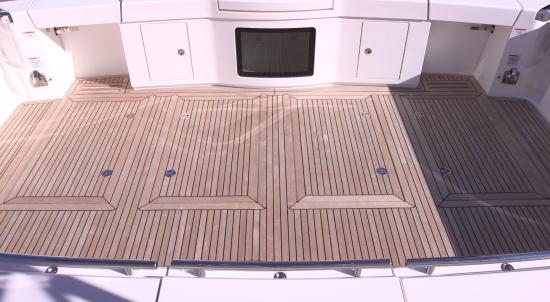
The cockpit sole of our test boat was covered in optional teak decking ($15,836), and the planks are all lined up from the teak shelf abaft the transom to the steps up to the mezzanine and with the planks on the mezzanine itself. Under the center of the cockpit sole is a metal plate so that a fighting chair or rocket launcher can be properly installed.
The working surface of the cockpit measures 8’8” (2.64 m) fore and aft, providing more than enough room for crew to guide a fighting chair from behind, as well as to slip in front of the rod.
Abaft the transom for its entire width on our test boat was an option called a “Swim platform” that we can only characterize as a 15” (40 cm) “shelf,” albeit one with teak decking on our test boat ($2,799). This provides minimal footing for getting to each side, for closing the transom doors, and a place to step when mooring stern-to, but overall, it is of limited use. Those wanting a real swim platform can have one fitted in the customization process.
A swim ladder is mounted under the shelf and internally, in line with the port transom door. The latches for the transom doors on our test boat were at the bottom, which makes them unhandy to unlock for portly crew. Placing them at the top of the door would make them easier – and safer -- to unlatch from the cockpit.
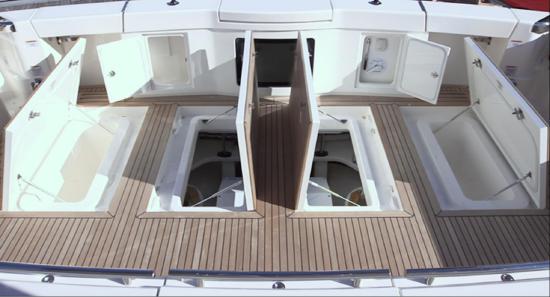
Cockpit Storage. There are two insulated fishboxes, outboard port and starboard, in the cockpit deck that measure 39”x16”x19” deep for 6.8 cu. ft. (.19 cu. m). In the port and starboard gunwales are storage compartments for rods, lines, boathooks, gaffs, and the like. The transom contains one shallow compartment as well as a large baitwell with picture window in the side. This can be outfitted as a livewell ($4,340). There is also storage under the grill in the cockpit console.
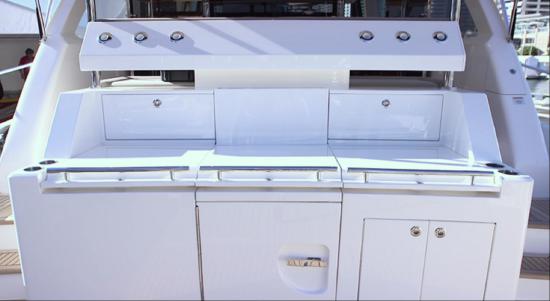
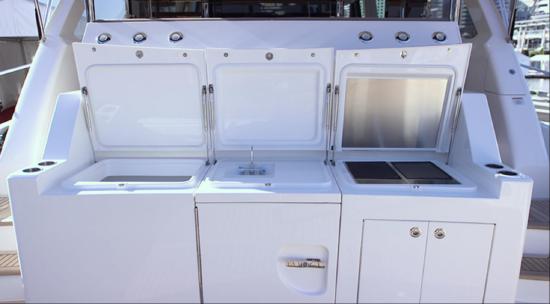
The cockpit console has a large, deep freezer to port, a sink, and a double electric grill to starboard – all under fiberglass lids with gas-assist struts. They are all standard. This arrangement turns the cockpit into an entertaining venue when not out sport fishing. With console lids down, the expanse becomes a welcome place to set out food and beverages during a cocktail party.
The Cockpit as an Entertaining Venue
Boat builders rarely mention it, but a large cockpit such as this one makes an ideal venue for a cocktail party, and before yachts had flying bridges and seats and tables on the foredeck, this is where everyone hung out. And, quite happily.
If the 72 were to be used more for entertaining than fishing, we would have fold down seats installed in the port and starboard gunwales in the customization shop to enhance the cockpit’s entertaining capabilities.
Engine Room Hatch. The engine room hatch from the cockpit has been cleverly placed under the sink on the centerline. Simply lift up that hatch and – voilà – the companionway to the engine room appears.
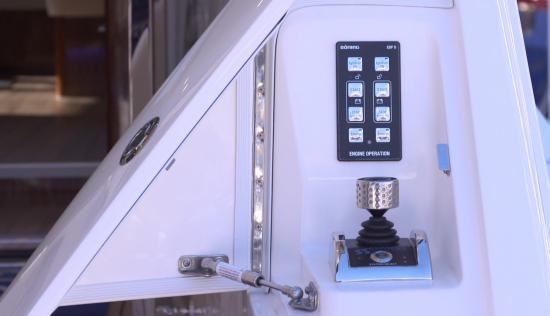
Cockpit Joystick. A helpful optional joystick was thoughtfully placed aft facing of the starboard side superstructure on our test boat. It is placed so that the skipper can stand on the steps going up to the mezzanine and see both the stern and down the starboard side of the boat. For portside tie-ups, a secondary helm with joystick has been placed aft on the port side of the flying bridge (standard).
The Lazarette
The lazarette is reached through two hatches in the cockpit inboard of the fishboxes. Our test boat had been fitted with an optional Seakeeper 16 ($112,149) which was installed on the centerline just below the hatches. Also installed there was the Glendinning Cablemaster, and the aft fuel tank.
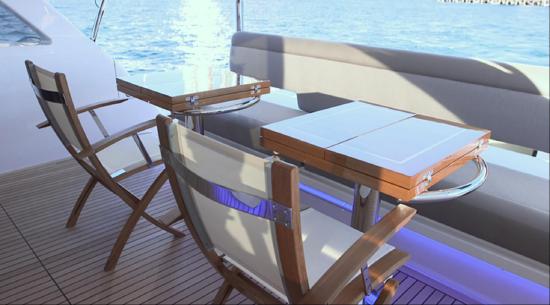
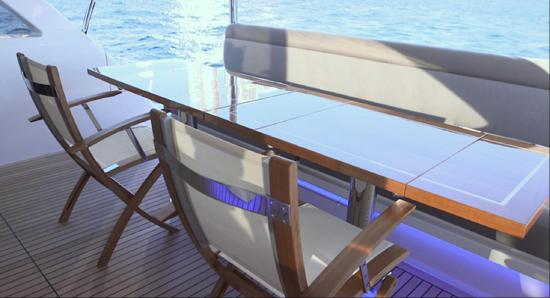
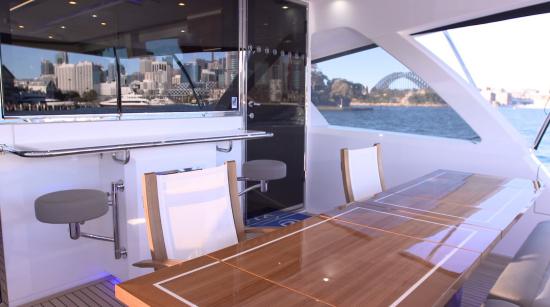
The Main Deck

The Mezzanine
There are four steps up from the cockpit up to the mezzanine and both the steps and the mezzanine sole are covered in teak, as standard. This will probably be the most used outdoor space on the boat: it has a commanding view of the cockpit and any sportfishing action going on there, and 10 people can sit at the table. The boat comes standard with five folding teak chairs. (They can stow under the seat, or forward under the salon sofa.)
The mezzanine is well protected from the sun by its overhead and the optional awning ($6,578), which we recommend. The overhead is 7’1” (2.15 m) high.
The mezzanine deck is 124.3 sq. ft. (11.55 sq. m), and that together with the square footage of the cockpit gives her a total of 300 sq. ft. (27.87 sq. m.), which is greater than any production convertible in class.
A casual bar counter with two swing-out stools add further utility. The polished stainless window frame swings up on a gas-assist strut, creating a snack bar on the mezzanine and fresh air for the galley.
A fold down 32” TV is tucked into the overhead, standard.
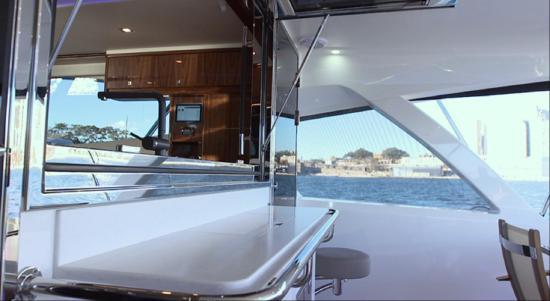
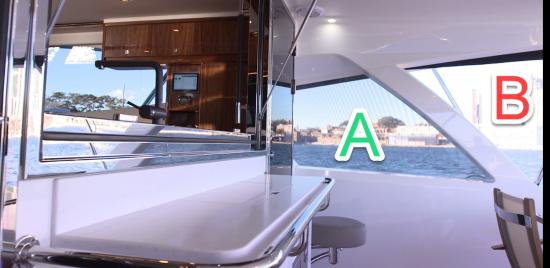
Day Head/Shower. Just to port of the snack bar is the companionway down to a wet head that can be used as a day head for bathers, and a handy relief station for guests when entertaining on the mezzanine, in the cockpit, or on the foredeck. It also doubles as the wet head for the optional crew quarters just forward of the engine room. This is a clever use of space that we have rarely seen on boats in class.
Button Her Up for an Extra Cabin. Because the overhead extends slightly beyond the settee, it can be buttoned up with isinglass to create a three season “cabin,” or onboard solarium. By opening the aft window and door, the space can even be heated or cooled. With this space, the main salon, and the sky lounge above, adults, kids of different ages, or even help, can each have their own semi-private place for conversation, games, TV watching, or just hanging out.
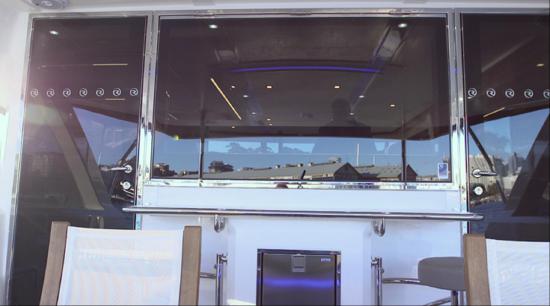
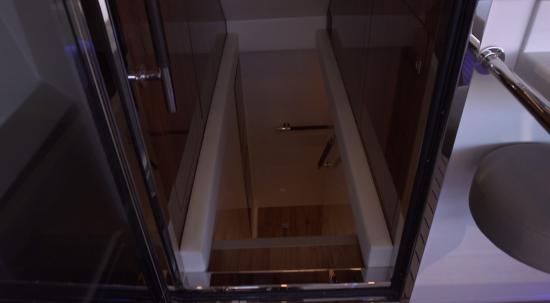
The Galley
The galley is placed aft as we often find on newer express cruisers, but almost never see on either motoryachts or convertibles or sportfishermen. This arrangement has several advantages, among them being that it is only a few steps to either the mezzanine dining table, or the one in the salon. The location also keeps the chef connected to the guests no matter where they are hanging out on the main deck, and the opening aft window brings in fresh air and keeps the galley from being claustrophobic.
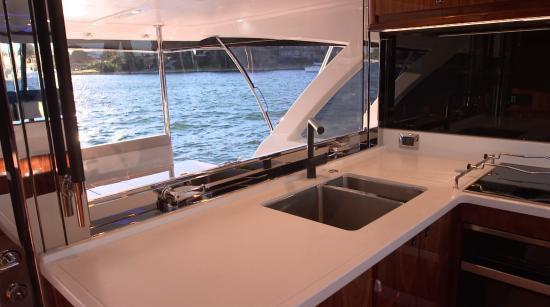
The galley has a traditional U-shape, and is to port with a 42” (106 cm) wide aisle, large enough for two people to work in the galley at the same time. The head of the “U” butts up against the twin stairways, one going down to the day head and crew cabin, and the other ascending to the sky lounge and helm. These stairs are effectively hidden by this design slight-of-hand.
There is a four-burner stovetop at the head of the alley, with a convection microwave oven below. Aft is a large sink with a small separate one for garbage with an optional Insinkerator ($1,264) on our test boat. A dishwasher is conveniently located just to the right of the sink, where it should be. Plates, bowls, and cups come standard with the boat and are held in place by dedicated structures in the drawers at different locations in the galley.
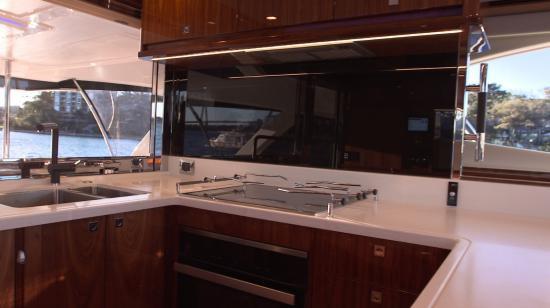
Counters. The forward part of the “U” is dedicated to food prep, and the counter is Corian which has been seamlessly melded together in what appears to be one solid piece. The counters on all three sides are deep, and there are Corian splash guards on three sides. There are slightly raised edges on the counter but they are not nearly high enough to be considered as functional fiddles. We’d like to see them higher, even if they are only one inch (2.5 cm) high.
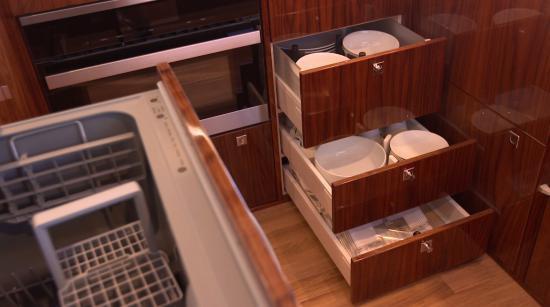
Two refrigerator drawers, storage for pots and pans, and drawers for flatware are all under the counter. All drawers are soft-close, and they, along with all cabinet doors must be manually latched with the push-pulls. Three cabinets above the stove are handy for dry goods.
The galley continues on the starboard side where there are four of the boat’s six refrigerator/freezer drawers, more pantry space, and more counter space.

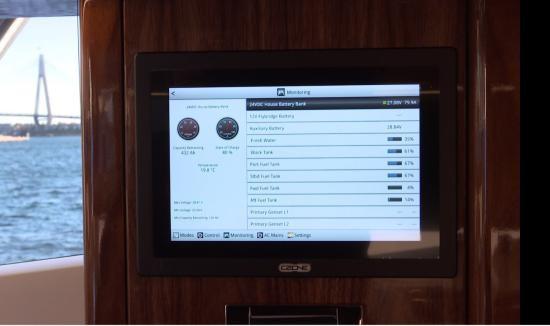
CZone. It is here that we find the CZone screen, to the starboard side when entering from the outside. Immediately upon entering, all of the lights and selected other systems can be turned on. This screen is one of two on the boat, in addition to being able to use an iPad to also control all electrical and other selected functions.
The overhead here and in the rest of the salon measures 6’7-1/2” (2.01 m). The decking is wood-grain vinyl which is used in virtually all of the best yachts these days.
Wood. All cabinetry, doors, door frames, and other joinery work on our test boat was made out of the optional high-gloss American Walnut ($11,243). White Oak and American Cherry are standard. American Walnut is rich and classy-looking and seems to never go out of fashion on boats. It is also in short supply, so the up charge is reasonable and, perhaps, a good deal at that.
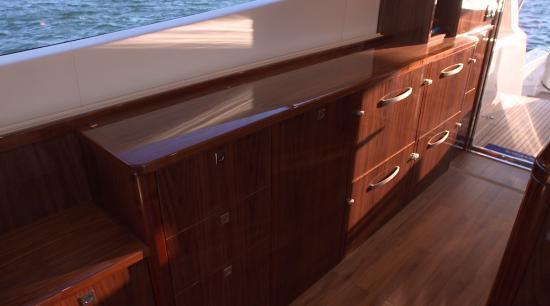
Salon
The salon is forward, which is unusual on both convertibles and typical motoryachts. It consists of an L-shaped settee to starboard with a high-low table with fold-out leaves, making it suitable for cocktails or a formal dinner. It also sides out, making it easy for people to get into the seats.
To port is another, equally-sized L-shaped settee, with an ottoman cum wood tray making a cocktail table, if wanted. Surrounding the salon on three sides are windows. We measured its overhead at 6’7.5” (2.01 m).
To port is a water-tight pantograph door, something that is unknown on convertibles/sportfishermen. The door is placed at the foot of the stairs to the flying bridge so the skipper can quickly leave the helm, go down the stairs, step out the handy door, then move forward to handle the ground tackle or mooring lines. As we have mentioned, this vessel is designed for short-handed operation, and this is a good example of how it’s done.
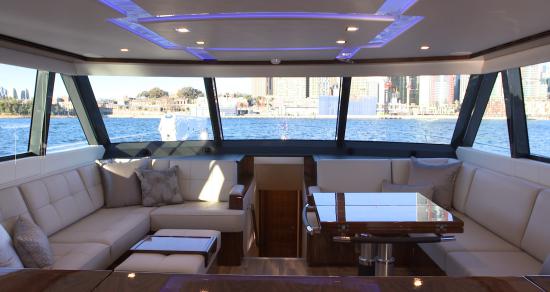
Materials. The settees are upholstered with premium-grade genuine Australian cowhide which has been meticulously prepared and inspected by Riviera’s in-house upholstery team. Three densities of color-coded foam are used to make the seats supportive and comfortable. The deck is covered in carpet with a plywood substructure. Vinyl wood-grained decking is an option.
The overhead is covered in light-colored vinyl with an attractive soffit design with recessed acrylic panels that glow with a variety of colors, depending on the ambiance the owner cares to create – cool disco blue, or warm, passionate pink, among other colors. All lighting is LED.
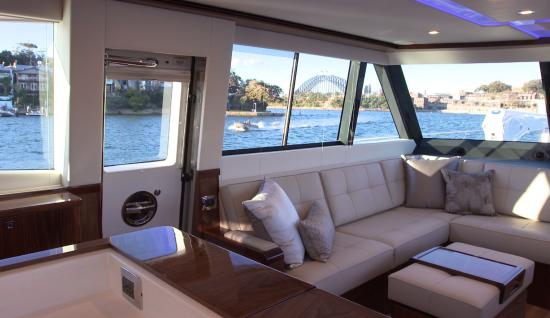
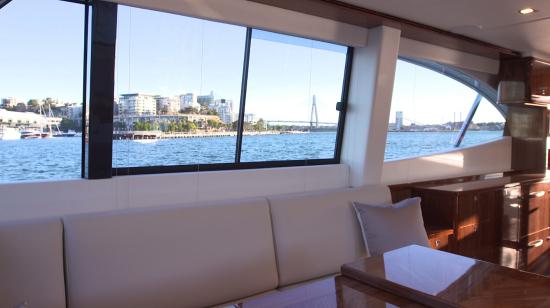
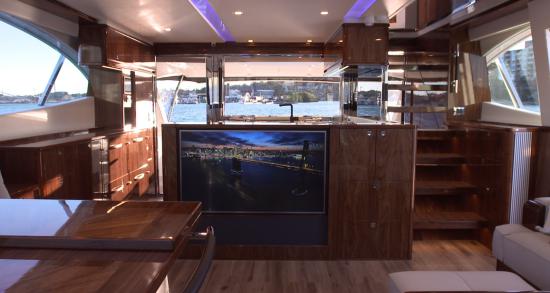
Comfort Details. There are blinds in the valances on three sides and the galley may be sectioned off with an electric descending blind. All air conditioning ducts are hidden and cool air comes wafting out gently from many points overhead rather than gushing from an unattractive grate. On each side of the salon, side windows slide back to bring in fresh air, again something that is often not done on motoryachts. 48,000 BTUs of AC/heat are dedicated to the salon.
The 50” TV is located in the forward cabinet and is on a hi-low electric lift.
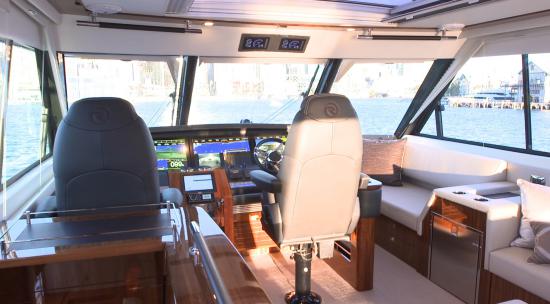
Enclosed Flying Bridge/Sky Lounge
By placing the helm on the flying bridge, Riviera is able to create a larger salon and give the captain better visibility. At the same time, a second salon is achieved – one we call a sky lounge – as well as a second aft deck. This gives the 72 a lot more living space without a commensurate increase in price. Essentially, it gives the vessel the inside living space of a conventional 85’ motoryacht.
The Helm. Riviera has designed the 72 to be as easy as possible for a couple to handle. To that end, it has placed the wheel on the centerline with good sightlines forward and to the sides. While there is glass virtually 360-degrees around the helm, docking stern-to would be a challenge for an owner/operator, were it not for the standard helm station on the open aft deck of the flying bridge. It is just a few quick steps from the main helm, and once the captain is there -- the wheel and joystick and controls make backing relatively easy.
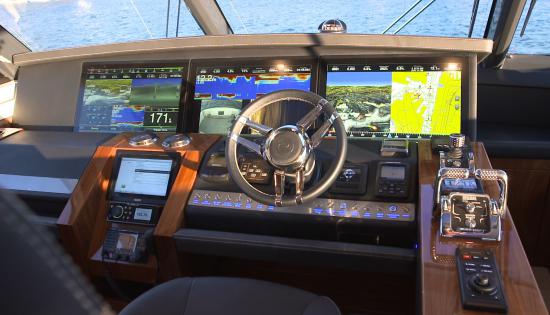
Glass Bridge. Three side-by-side 24” screens span the distance from the skipper’s pod across in front of the companion, are connected to optional electronics as well as engine and other data points ($46,163).
Basic Electronics and Controls. Perhaps the most important items of standard equipment are the Twin Disc Quick Shift digital controls, combined with the joystick that ties in the two main engines and the standard bow thruster. An optional stern thruster with connections to all three joystick locations was fitted to our test boat ($57,315). Standard items at the main helm include—
- CZone
- Monitoring and switches for all tanks via CZone
- Autopilot
- Cameras to engine room, salon, and anchor
- Chain counter
- Compass
- VHF radio
- Intercom to galley and engine room
- Remote control searchlight
- Leather-wrapped steering wheel
To the left of the helm, is the CZone screen from which most of the systems on the boat can be controlled. Also, to the left is the VHF radio which is handy and its screen can be easily read. In front of the helm are the normal switches and dials. The engine diagnostics can be displayed on the screen in digital or analog form. A 4.75” compass is mounted directly ahead. All windshields have defoggers and there are three pantograph windshield wipers with fresh water spritz.
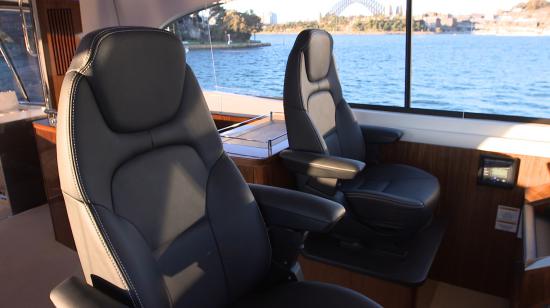
The helm is equipped with red lights for night operation. We particularly like the rudder angle indicator and the Muir anchor windlass control with chain counter – an absolute must.
At the main helm, both the captain’s chair and that of the companion are made by Norsap, a Norwegian company, and look like they are right off of the starship Enterprise. They are fully electrically adjustable, have folding arms and footrests, and a high back and head support. They are a big step up from the de rigueur Stidd seats we often see.
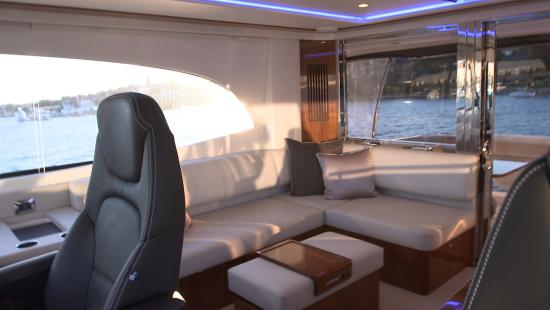
The Sky Lounge. Polished stainless steel railings lead up to the sky lounge/helm and on the overhead there are handholds, a signature detail of Riviera boats. The decking is vinyl. To starboard is an L-shaped settee covered in the same premium leather that we saw below.
The sofa makes into a bed (bedding not provided), which effectively creates a fifth stateroom in a pinch. There are manual pull down blinds on all sides.
To port is an entertainment center, complete with wet bar that includes a sink, refrigerator, and icemaker. The sky lounge is cooled/heated by two 18,000 BTU reverse-cycle units. The two windows by the helm slide back and there are two electrically operated sun roofs overhead for fresh air.
The after bulkhead window opens on gas-assist struts, just like the one below. The requisite TV screen is 32” and to port in the console, and like all of the rest of the TVs on the boat, can be operated from an iPad with the CZone software.
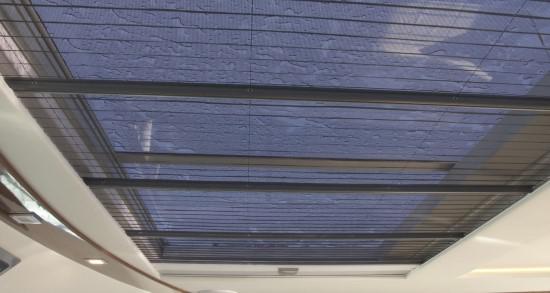
Flying Bridge Aft Deck. To starboard on our test boat was an L-shaped settee covered in all-weather Sunbrella upholstery and a high-gloss hardwood table. This is a particularly pleasant place for cocktails or dining because of the views, shade, and privacy. The deck is surrounded with polished stainless steel rails. This perch is the best one on the boat.
To port is the aft helm which we have already described. Here, an icemaker or refrigerator can also be installed.
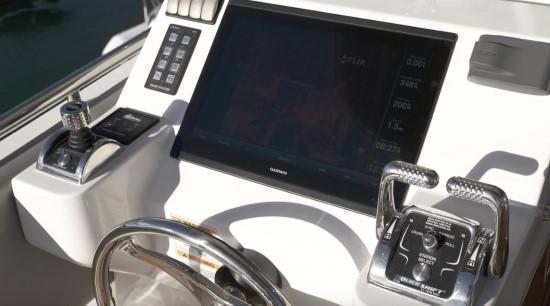
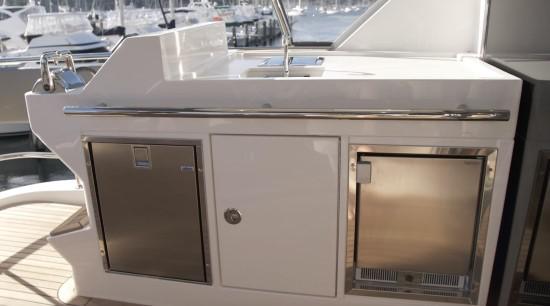
Why is the Wheel Aft? There are two very good reasons. The Riviera 72 Sports Motor Yacht has straight drives with rudders. When docking without the standard joystick (let’s say it has gone on the fritz), by turning the wheel to one side or the other, the huge props will ease the stern of the boat in the desired direction by putting the engines in and out of gear, appropriately, and letting their prop wash against the rudders and kick the stern in the desired direction.
A second reason, is so that the boat can be used as a full-fledged sportsfisherman. From the aft helm, the skipper has a perfect view of the cockpit action, the line, and perhaps the gamefish as well. Not only is this an ideal location to judge how to back down on a fish and keep the transom pointed at the prey, but it is indispensable when running alongside a spooked billfish. A joystick and bow thruster are not enough in this situation, which is not uncommon when tangling with large marlin to run with it.
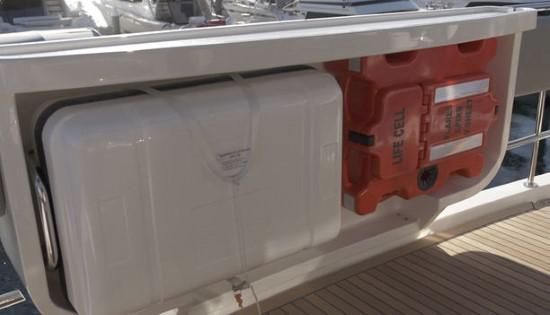
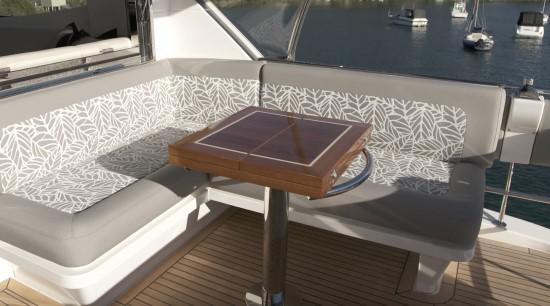
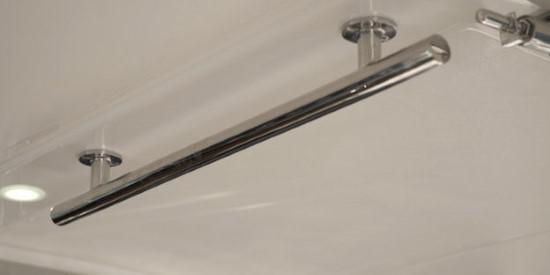
The Bow
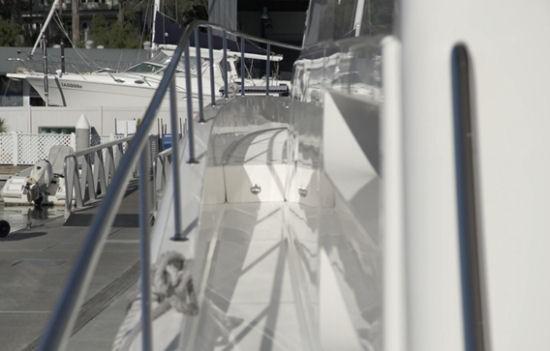
Side Decks. The bow is reached from the aft deck along symmetrical side decks that are nearly 14” (35.55 cm) wide with bulwarks that are 12” (30.48 cm) high. The bulwarks are an important safety feature when going forward on a wet deck on a snotty day – and it is something most convertibles don’t have. The polished stainless steel safety rail is 32-3/4” (83.18 cm) high, which exceeds CE and ABYC standards. Our test boat did not have a handhold along the cabin side, which Riviera would be happy to add for any owner requesting it.
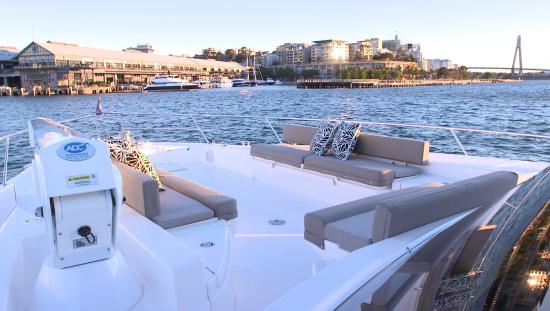
The bow is designed to be used for multiple purposes: sunning, a picnic, cocktail party, and for carrying the ship’s tender – not all at the same time, of course. The trunk cabin top has molded-in storage compartments as well as molded-in longitudinal places for cushions and seat backs which can be inserted. Each of the facing seats is 82” (2.08 m) fore-and-aft, and can comfortably accommodate four people, making eight in total. There is a seat at the front of the superstructure that is 46” (1.16 m) wide and it folds up out of the way when towing the tender. All of this makes the bow functional for sunning or a cocktail party.
The addition of two tables on the centerline, adds even more utility and with the tables in place the venue can even be used for al fresco dining. When not in use, the cushions, seat backs, and tables all stow conveniently in the storage lockers in the bow. All of this lounging gear is optional – $17,214, including the table and an insulated ice chest.
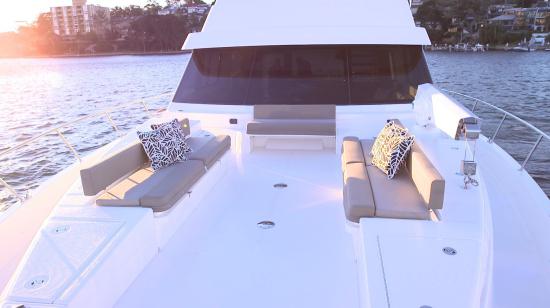
The Ship’s Tender. The yacht comes standard with a hydraulic davit; 1,200 lb. (550 kg) capacity which is operated by a handheld controller. The tender will rest on a removable cradle and be strapped down to the deck. There is a handy DC charging plug to keep the tender’s battery topped off. This is an ideal place to stow the tender, and when properly strapped down can even survive green water over the bow.
The beauty of this system is that when the boat is underway, it is not safe or comfortable to be hanging out on the foredeck, so why not use it for the tender? And when at anchor, or in port, the tender can be launched, permitting the bow to be used for a party.
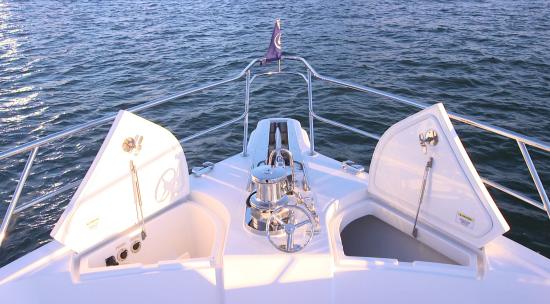
Anchoring. Forward, there is a “working pit” for handling the ground tackle, meaning that it can be handled easily by bending over and not having to get down on hands and knees. The hydraulic windlass is operated by a handheld device or by remote from the enclosed helm. There is also a much-needed chain counter, which makes anchoring less worrisome at night when chain markings are hard to see.
There are both a freshwater and raw water faucets at the bow for anchor and chain washdown. We like the large hatch to the chain locker which is big enough for an adult to enter if need be to untangle chain after a bouncy passage.
Ground Tackle. Riviera has left nothing to chance, and equips the boat standard with the precise ground tackle that should equip the boat. The anchor is a polished stainless steel 1,176 lb. (80 kg) Ultra, with 328’ (100 m) of 1/2’’ (13 mm) galvanized chain. The Ultra comes with a swivel and cruise safety strap, and safety harness securing eye bolt to foredeck. Cleats are 13” (3.96 m).

Accommodations Below Decks
Master Stateroom
There are two layout plans available for the 72, the one on our test boat with the head on the starboard side of the master, and the Presidential layout, which replaces the fourth guest stateroom on the starboard side with the master head.
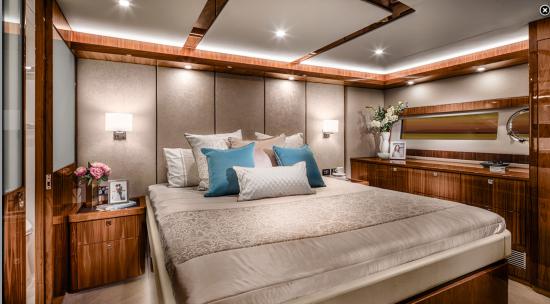
We measured the headroom in the master at 6’5” (1.95 m). The master bed measures 71” wide by 78” head to foot (1.80 m x 1.98 m). Our test boat the “Classic” layout (the one on top, above) with the head to the starboard side of the cabin. This stateroom had the same walnut joiner work that we saw above. Bulkheads both here, in the passageways, and in the other guest cabins, had an attractive herringbone weave with padded backing on our test boat. Its texture and color were tasteful (selected by the owner) and do not overpower or steal the show from the fine, high-gloss woodwork and polished stainless steel.
On either side of the bed are walnut night stands with inlayed leather tops and 1” (.30 m) high fiddles that should keep watches, cell phones, and the like in place. Electrical outlets and USB ports are thoughtfully placed above each night stand, and there are other buttons for lights to starboard. Every bed on this boat has a reading light.

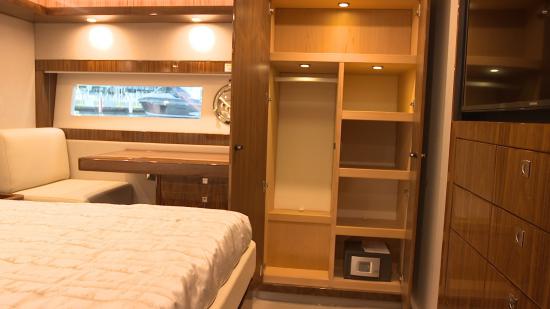
On the forward bulkhead is a 40” TV screen and below it are drawers. Drawers are also under the bed, which raises on gas-assist struts for bulk storage. There is 18,000 BTUs of reverse-cycle HVAC dedicated to this space.
To port is a full-height cedar-lined hanging locker with automatic LED lighting when the doors are opened. There is a rack for shoes. Abaft this structure is a small chest of drawers with a forward facing seat and vanity/work station for one. The deck was carpet over plywood substructure.
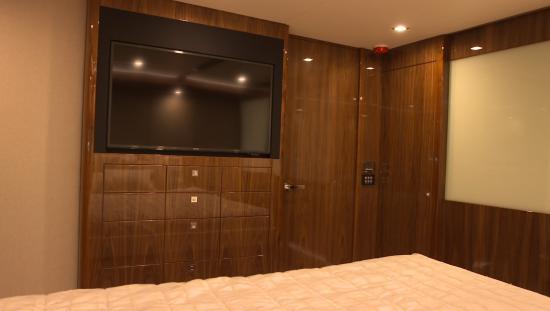
Opening Portlights. In addition to the glass side windows – which are molded in and we are told that they are stronger than the hull side itself – are opening portlights, port and starboard with polished stainless steel deadlights over them. (This makes them ultra-secure.) The portlights on our test boat did not have a device to hold them open, which is an easy fix. Both portlights have sensors to alert the captain at the helm if they are open. They also have fly screens.
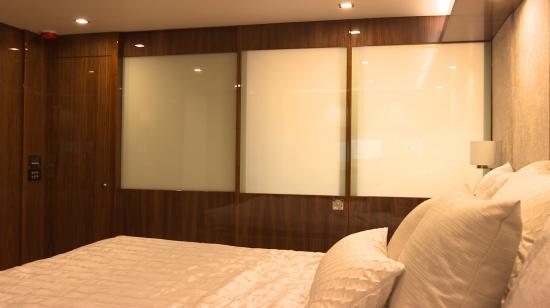
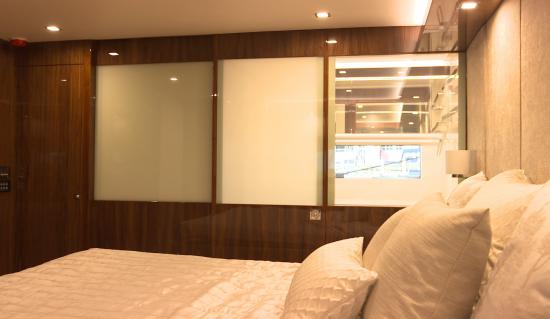
The Head is to Starboard. Its bulkhead separating it from the stateroom has wood paneling that is waste-high, then what appears to be three frosted glass panels going to the overhead for privacy. But with the touch of a button, the aft glass panel becomes transparent to bring light into the cabin.
Inside the head, there is a large horizontal window in the hull side and an opening portlight with deadlight. The head has a large, single wash basin below a Corian counter top, a large separate shower stall with adjustable shower head and mixer controls. The walk-in shower stall is large, has a glass door on two brass-colored hinges, a fiberglass bench, an adjustable shower head with a pre-set temperature mixer, a scored Corian deck, and an automatic shower sump.
Master Head in the “Classic” Layout
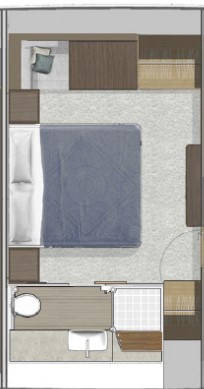
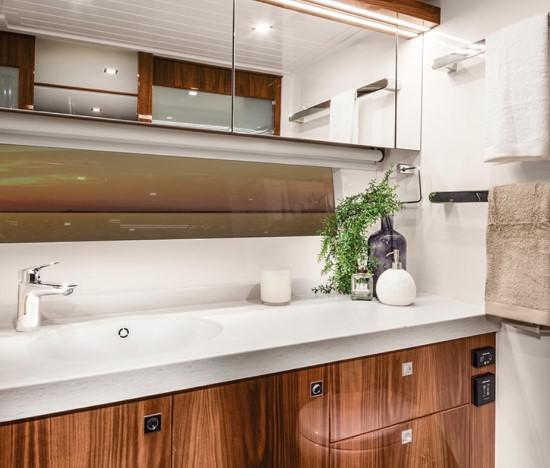
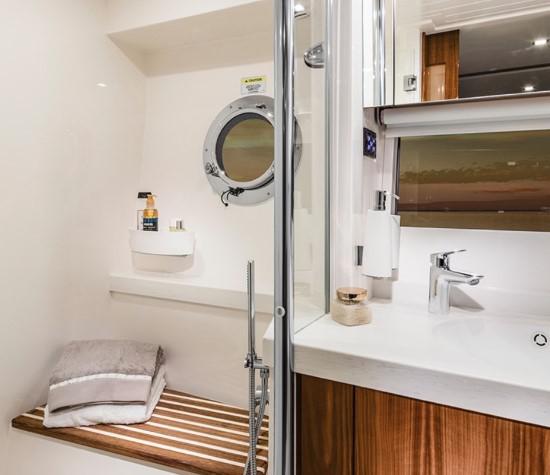
“Presidential” Layout
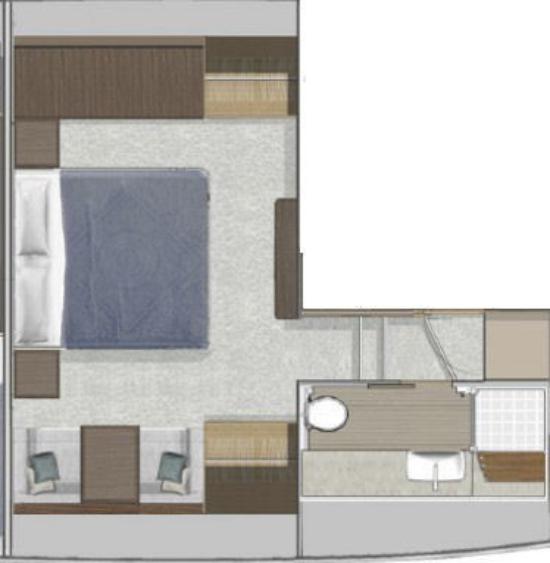
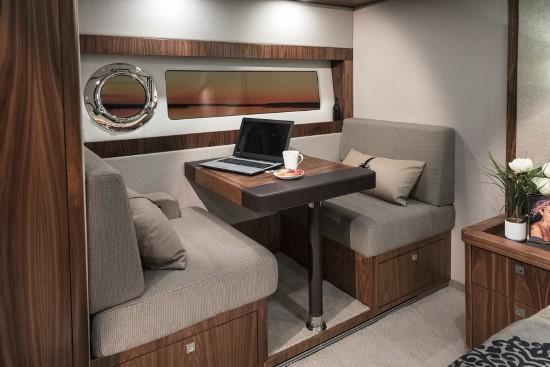
Amenity. Just outside the door to the master is a wine cooler. It is placed here to be handy to both the owner and his thirsty guests in the other cabins.

“Presidential” Layout. As can be seen in the layout above, the Presidential layout places the master head forward and up two steps from the master deck. While the head itself is about the same size as in the “Classic” layout, the stateroom itself picks up space for a his-and-hers booth for morning coffee or evening champagne. In this layout, the wine cooler is safely ensconced in the master.
Owners should consider how they are going to use the boat and how many people will use it. By opting for the bed or a Pullman in the crew’s quarters, and with the fold out bed in the sky lounge, there are places for three or four extra people to sleep in a pinch.

Forward Stateroom – VIP
This en suite stateroom has 6’5” (1.95 m) of overhead at the foot of the bed and in the head. The inner spring mattress measured 49” wide and 76” from head to foot (1.24 m x 1.93 m). 16,000 BTUs of HVAC are dedicated to this stateroom. A 32” TV is on the forward bulkhead.
Port and starboard are horizontal windows that bring in lots of light, and that together with the large Bomar hatch overhead, make this cabin bright. The overhead hatch has an OceanAir blind and screen, and the side windows also have curtains. To starboard is a cedar-lined hanging locker, and to port are cubbies and drawers. There are also four drawers under the bed which lifts up on a gas strut.
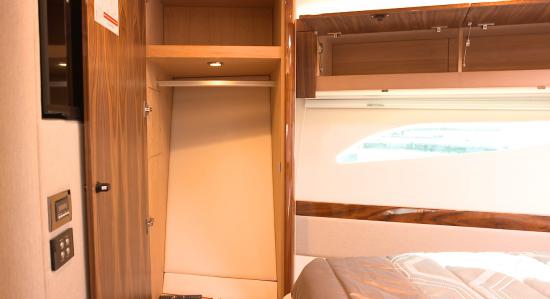
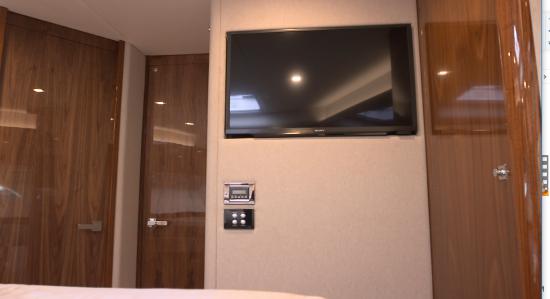
Clearance Space. There is from 13” to 14” (33 cm to 35 cm) clearance between the port and starboard lockers and the bed frame. The deck is carpet over plywood. We like the cabinets outboard up against the overhead which use the bow flare for much-needed added storage. The walnut finished cabinetry also give this room a cozy, classy feel.
Port Stateroom
This stateroom has twin beds with a single night stand between them. The inboard bed measures 26” (66 cm) wide and the outboard bed is 24” (60 cm) wide. Both are 77” (1.95 m) head to foot. The inboard bed is on tracks and can be moved outboard to form one double. When one bed is created, a night stand emerges magically from under the head of the bed on the inboard side.
The overhead clearance is 6’6.5” (1.99 m). Outboard is an in-hull window, the deck is carpeted, and there is 10,000 BTUs of reverse cycle air conditioning dedicated to this space.

Of the two amidships guest staterooms, this is the preferred one not only because it is larger than the other, but also because it has private access to its en suite head, which serves triple duty as the head for the port stateroom, and perhaps also as a second day head. (The head in the crew quarters is the primary day head.)
The head has a separate shower stall. All of the heads have Corian countertops and Corian decking in the shower stall.
In the passageway, forward of this head, is the stacked washer/dryer behind a door.
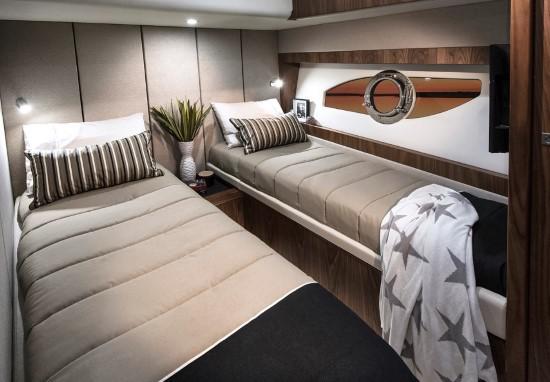
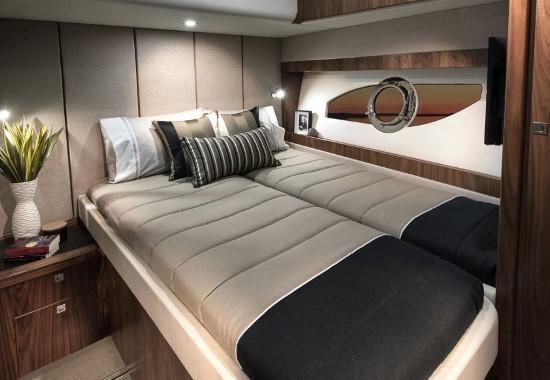
Starboard Guest Stateroom
The starboard stateroom has bunk beds up against the hull. The upper bunk measures 30” (76 cm) wide due to the hull flare, and over the outboard half of the bed the overhead clearance is 12.5” (31 cm). The lower bunk is 24” (60 cm) wide. Both are 77” (1.95 m) head to foot. Overhead clearance in the cabin is 6’6.5” (1.99 m).
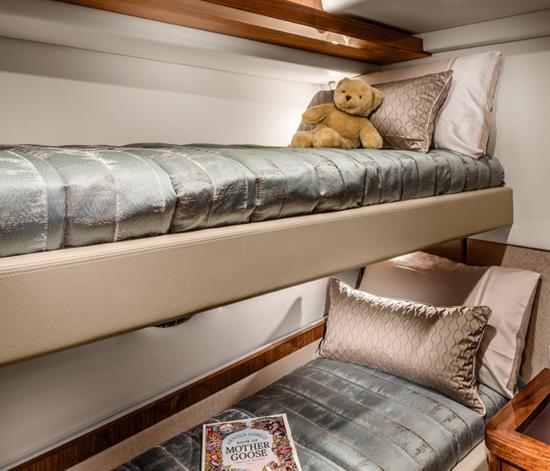
There is a horizontal window in the hull side as well as an opening portlight with deadlight beside the lower berth. Beside the lower bed is a cabinet with drawers and there is storage under the lower berth. At the foot of the bed is a hanging locker. 8,000 BTUs of HVAC are dedicated to this cabin. Like all of the beds aboard the 72 Sports Motor Yacht, it has what the company describes as a quality mattress.
This cabin is replaced by the master head in the “Presidential” version.
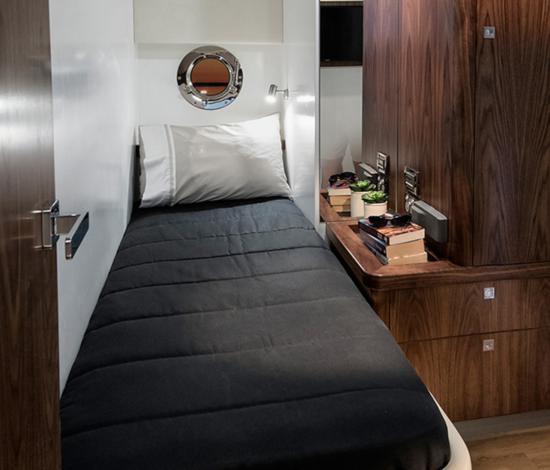
Crew Cabin/Utility Room and a Head
The space between the master stateroom and the engine room is what Riviera calls a utility room, but it also can be an optional crew cabin ($22,722).
A wet head lies between the engine room and the master stateroom and is accessed by a staircase from the aft deck, as well as from the engine room. Because the head is located outside of the cabin area, it is a perfect place for swimmers to come and take a shower and use the facilities, without having to go through the living areas of the boat. It can also serve as a day head.
In our test boat there was just a single bed installed, but a Pullman berth can be placed on the forward bulkhead of this space over the single bed.
Multi-Use Space. Since this boat is designed as an owner/operator boat, this cabin can be an ideal place for children or grandchildren who will like its out-of-the-way location. But, other owners may want it for a cook, a deck hand, or a nanny. Other owners may choose to use it as storage or a workshop. Scuba divers will like it to store their wet suits, dive gear, and underwater cameras. (Tanks and an air compressor can be fitted in the large lazarette instead of the Seakeeper gyro.)
Engine Room
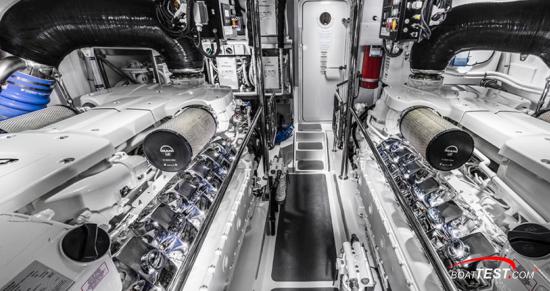
The engine room is accessed from the cockpit under the centerline sink, or from the watertight door in the crew’s quarters. The headroom on the centerline is 6’5” to 6’8”(1.95 to 2.03 m) and there is 28” (71 cm) between the MAN 12V 1900-hp diesel engines. Two Onan generators come standard: 27.5 kW and 13.5 kW, so that the owner can match the load to the appropriate gen set. All reverse-cycle air conditioning condensers are located in the engine room, along with the master CZone control panel.
MAN V12 1900-hp Diesels. MAN calls them the “King of the Lions,” and they are the highest horsepower engines that MAN Truck & Bus produce (Upgrade charge from the standard MAN 1800-hp engines, including the Twin Disc marine gears and joystick controls in three locations: $192,401).
The Bavarian engine maker says that the marine version of the 1900-hp model was intended for motoryachts over 100’ (30.4 m). Because MAN supplies truck and bus manufacturers all over the world, it has a global service organization. The engines weigh 5,219 lbs. (2,365 hg.) each, dry, without the marine gear and shafts, giving them a power to weight ratio of 2.7 lbs. per horsepower. The 90-degree V-12 4-stroke engine has a displacement of 24.2 L, and has 4 valves per cylinder.
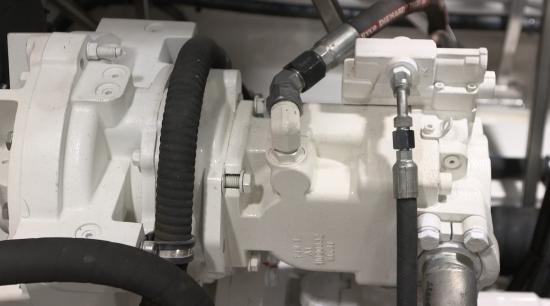
The torque of the engines is rated to be 6,220 Nm (Newton meters) straight line from 1200 to 2100 rpm. This is perhaps the engine’s most important attribute as attested to in our acceleration tests. Instrumental in creating this prodigious torque is the engine’s air intake which is turbocharged with a charged intercooler system that acts sort of like a second turbocharger. The engine uses a plate heat exchanger which is cooled by seawater.
Distinguishing Features of the Engine Room. After the engines and the headroom comes Riviera’s attention to detail and safety. All fuel-handling hoses are swaged. There are both ss gates and ss plates that keep anyone from falling into the turning shafts of the V-drive. This is a belt and suspenders safety system. Unfortunately, the polished ss safety plate restricts access to the engine raw water sea strainers, so we would like to see this plate modified.
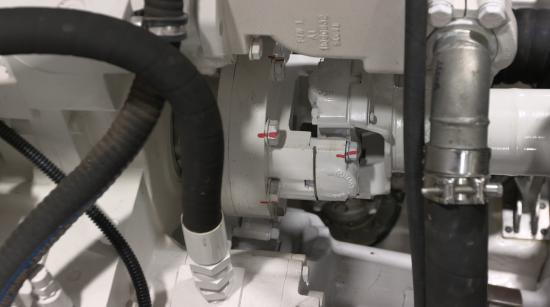
Noteworthy is the fact that the torque applied to all hose clamps is prescribed on the vessel’s work sheet and is checked by a second person. The first person puts a red dot on the hose clamp, indicating that it has been tightened to the required pressure in ft. lbs., and a second person checks it, and puts a yellow dot on the fitting. This level of care is unusual on any type of boat. The same process is undertaken for engine mounting bolts, with a red line indicated the proper torque and a yellow line attesting to its correctness. Observant owners can tell at a glance if the bolt has backed off from vibration.
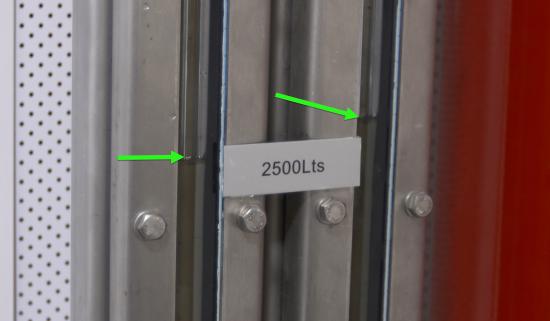
Other noteworthy details we saw in the engine room—
- Demisters. Marine Air Flow makes the air-intake demisters, port and starboard for keeping the salt spray out of the engine room. The air intakes are in the side of the superstructure, not in the hull.
- Delta-T Exhaust Fans. Delta-T makes fans that can be run continuously, and which are totally waterproof and spark proof.
- Seatorque Coupling. The Seatorque Bolt On Shaft System (BOSS) separates the prop shaft from the drive shaft through thrust bearings in the gold casing seen in the picture on this page. This is an important advancement in yacht propulsion systems as the prop and shaft are no longer connected directly to the engine. This system greatly reduces vibration and noise.
- Hydraulic PTOs. Hydraulic lines come from PTOs on the marine gears to power both the bow thruster and the bow windlass, and on our test boat the hydraulic stern thruster, as well. This is substantially better than using electric motors for both functions.
- Fuel Tankage. The 72 Sports Motor Yacht can hold as much as 2,774 gallons (10,501 L) in four tanks, including an optional ($24,975) 396 gallon (1,500 L) tank under the crew quarters. Standard tankage is 2,378 gallons (9,001 L) contained in two saddle fiberglass tanks outboard of the engines, and one smaller tank in the rear.
- Seakeeper. Located in the lazarette adjacent to the engine room is an optional #16 Seakeeper which we are told can affect a 84% reduction in rolling from 4’11” (1.5 m) beam-on swells when the vessel is at rest.
- Air Conditioning. Riviera reports that the total capacity of the reverse cycle air conditioning system in the 72 Sports Motor Yacht is 166,000 BTUs.
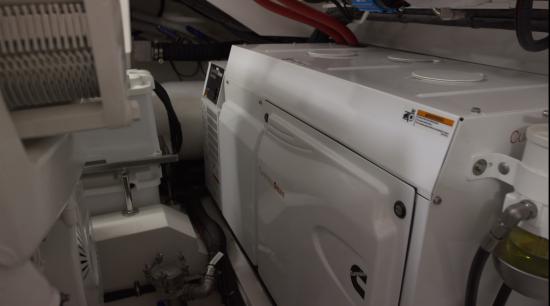
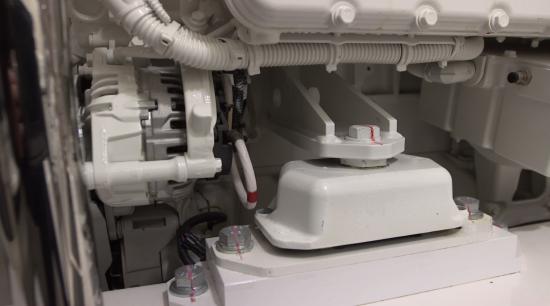

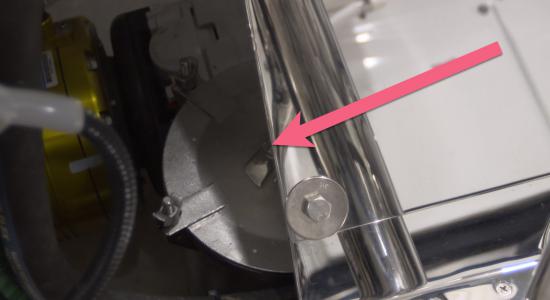
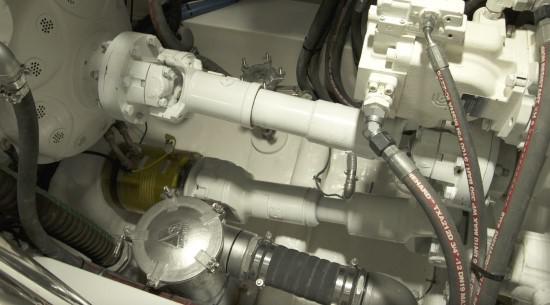
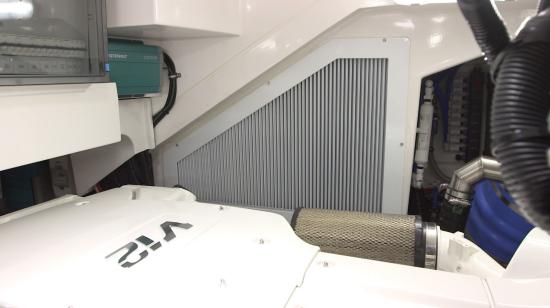
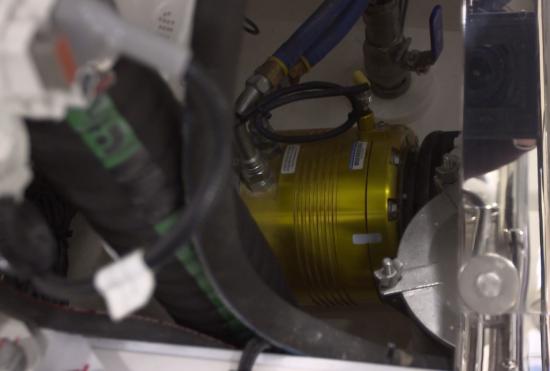
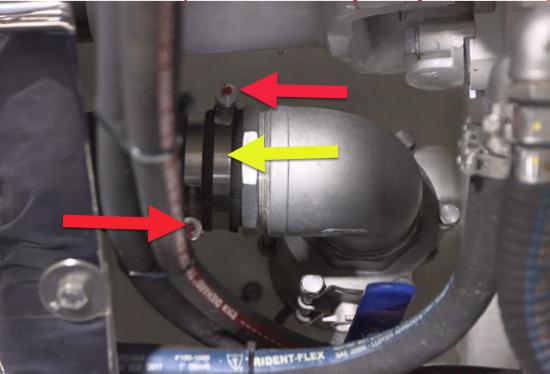
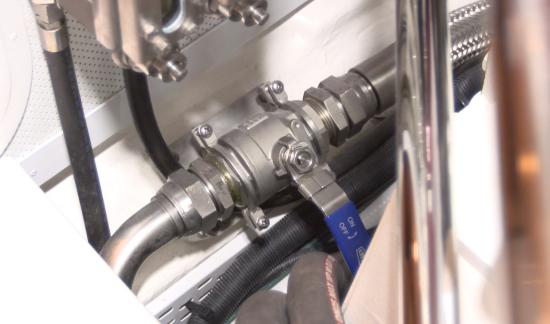
Construction
It takes eight weeks to laminate a Riviera 68 or 72 Sports Motor Yacht hull, and is left in the mold for that time to cure. This is good practice to ensure that the hull is fully cured and holds its shape when released from the mold.
Stringers and structural bulkheads are laminated in while the hull is still inside the mold. This is the traditional way of building a strong hull, but obviously it limits the number of boats that can be built a year to just 6, as Riviera has only one 72’ mold. We were told when we visited the Riviera facility that they are hoping to be able to reduce this stage of construction to six weeks in the near future.
The Laminate. After the gel coat is sprayed in, Riviera then adds a proprietary mixture of vinylester resin and DCPD resin, which has all of the osmosis-stopping properties of vinylester but adds to that a hardness that is able to withstand very high impact with good fatigue characteristics.
Chop strand with polyester resin is then applied, and then layers of double-bias mat, multi-directional cloth, and woven roving are laid into the hull, all with alternating layers of polyester resin which is then rolled out in the conventional manner. Once the hull has cured, cored samples are taken from around the hull where through hull fittings, portlights, and the like will be located and are sent to Riviera’s in-house lab.
Lab Testing the Laminate. Riviera’s engineers have strict ranges for the amount of resin and glass that should be in each area of the hull. The core samples from each hull are weighed, then put into an autoclave where the resin is melted away and the glass is weighed. In this way, Riviera is able to control and monitor the percent of glass in each area of the hull to make sure it meets spec. These core samples – about a dozen from each hull – are then logged and put in the boat’s construction portfolio that follows the hull around the plant as it goes thru each stage of construction. This data is saved on a computer and is part of the individual vessel’s documentation.
The bottom of the Riviera 72 Sports Motor Yacht is solid glass, and the keel, chines and strakes are filled with solid GRP. Coremat is used in the side of the hull above the waterline, and different thicknesses of PVC closed cell foam, and end-grain balsa core are used in the deck and superstructure for stiffening with light weight.
Is She Heavy? Because she is not resin-infused, the question begs -- is she heavy? When we compared her to other production boats her length from respected builders, the sportfishermen/convertibiles, sky lounge motoryachts, and conventional flushdeck motoryachts were all heavier than the Riviera 72 Sports Motor Yacht, except one. So, the answer seems to be that Riviera is doing a good job of hand layup.
Foamed Bottom Forward. One of the construction details that we think deserves special comment is that the forward part of the boat is filled with expandable PVC foam under the floors. This is quite unusual for boats of this size and class. We were told that the foam was added to reduce sound while running. But the foam will do more than that.
By foaming in compartments between the stringers and structural bulkheads and transverse frames that can’t be reached for cleaning, the builder thereby eliminates them as a concern for the owner when it comes to mold and mildew. It also keeps components from rattling – rattles they would otherwise never be found.
While its intended purpose is not to keep the boat from taking on water, if the bow area is punctured, it will certainly slow any such flow. We like this attribute, and few builders in class do it.
There is a watertight “crash” bulkhead forward.
Vessel Construction Documentation
At each stage of construction, more pages in the vessel’s dossier are filled out with part numbers, the names of the shop personnel doing the work as well as the name of the QC inspector at each station in the process. Every important detail gets logged in the portfolio.
Some pages in the construction directions give specs that must be met during the construction process. For example, every bolt and hose clamp has a torque spec. The installer tightens to that spec and marks the bolt or hose clamp with a red dot, then a QC inspector checks it and marks it with a yellow dot. This is unusual in boat building in any class.
A BoatTEST video that goes into detail of the Riviera build process should be referred to for more detailed information.
Optional Equipment to Consider
Most of the optional equipment that we would recommend was on our test boat, but these are the items we feel give added value to the vessel or make handling easier—
- Stern thruster
- Crew cabin
- Presidential Master Stateroom
- Rear awning
- Forward deck lounge
- Walnut cabinetry
Price
Base price of the Riviera 72 Sports Motor Yacht is $4,264,600 powered by twin MAN 1800-hp engines. And at that price, the boat is fully equipped and ready to sail away in style. But some people want all of the bells and whistles, and our test boat which was fitted out to the nines, sells for $4,904,392, powered by the MAN 1900-hp engines.
Observations
As of the summer of 2018, Riviera could produce a total of just six 68 and 72 units because the company has but one mold and it takes two months to properly laminate the hull, install the watertight heads and fill the bottom with foam. The company’s goal is to reduce the hull’s time in the mold down to six weeks so that eight of these boats can be built per year.
After the hull is extracted from the mold, it will spend an additional 28 weeks in the build process until it is put in the water for sea trials and testing – for a total of 36 weeks from start to finish.
All of this means that only six to eight lucky people in the world will be able to take delivery of either the 68 or 72 Sports Motor Yacht. That alone adds value to the boat.

